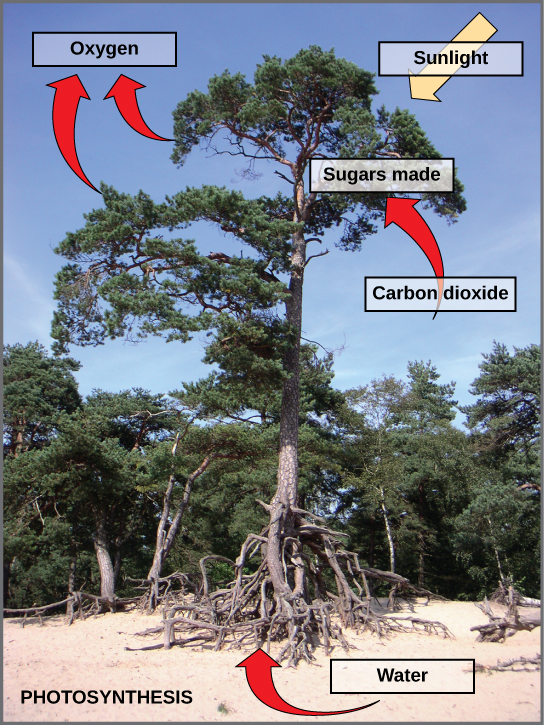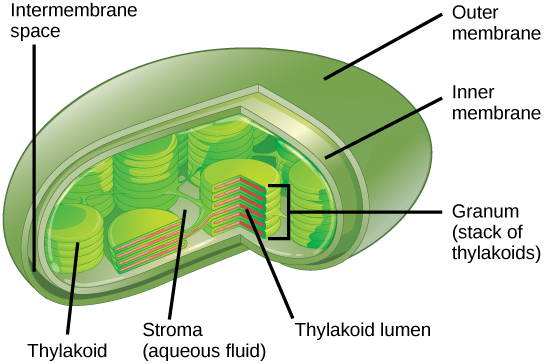4.1.3: Photosynthesis Overview and Equation
- Page ID
- 31987
Learning Objectives
- Explain the relevance of photosynthesis to other living things.
- Identify the substrates and products of photosynthesis.
- Describe the main structures involved in photosynthesis.
- Relate the light-dependent and light-independent reactions.
Plants, algae, and certain bacteria (cyanobacteria and green and purple sulfur bacteria) are among the organisms capable of performing photosynthesis (Figure \(\PageIndex{1}\)). Because they use light to manufacture their own food, they are called photoautotrophs (literally, “self-feeders using light”). Other organisms, such as animals, fungi, and most other bacteria, are termed heterotrophs (“other feeders”), because they must rely on the sugars produced by photosynthetic organisms for their energy needs. A third very interesting group of bacteria synthesize sugars, not by using sunlight’s energy, but by extracting energy from inorganic chemical compounds; hence, they are referred to as chemoautotrophs.

The importance of photosynthesis is not just that it can capture sunlight’s energy. Photosynthesis is vital because it evolved as a way to store the energy in solar radiation (the “photo-” part) as high-energy electrons in the carbon-carbon bonds of carbohydrate molecules (the “-synthesis” part). Those carbohydrates are the energy source that heterotrophs use to power the synthesis of ATP via celluar respiration. Therefore, photosynthesis powers 99 percent of Earth’s ecosystems.
Photosynthesis Equation
Photosynthesis is a multi-step process that requires sunlight, carbon dioxide (which is low in energy), and water as substrates (Figure \(\PageIndex{2}\)). After the process is complete, it releases oxygen and produces glyceraldehyde-3-phosphate (GA3P), simple carbohydrate molecules (which are high in energy) that can subsequently be converted into glucose, sucrose, or any of dozens of other sugar molecules. These sugar molecules contain energy and the energized carbon that all living things need to survive.

The following is the chemical equation for photosynthesis (Figure \(\PageIndex{3}\)). Although the equation looks simple, the many steps that take place during photosynthesis are actually quite complex.

Structures of Photosynthesis
Before learning the details of how photoautotrophs turn sunlight into food, it is important to review the structures involved. Recall from the Leaves chapter that leaves consist of several layers of cells, and the process of photosynthesis occurs in the mesophyll (middle layer). Note that other parts of the plant, such as the stems, are photosynthetic as well. The gas exchange of carbon dioxide and oxygen occurs through the stomata (singular: stoma), which also participate in water balance. The stomata are typically located on the underside of the leaf, which helps to minimize water loss. Each stoma is flanked by guard cells that regulate their opening and closing.
In all autotrophic eukaryotes, photosynthesis takes place inside the chloroplast. For plants, chloroplast-containing cells exist in the mesophyll. Chloroplasts have a double membrane envelope (composed of an outer membrane and an inner membrane). Within the chloroplast are stacked, disc-shaped structures called thylakoids. Embedded in the thylakoid membrane is chlorophyll, a pigment (molecule that absorbs light) responsible for the initial interaction between light and plant material, and numerous proteins that make up the electron transport chain. The thylakoid membrane encloses an internal space called the thylakoid lumen. As shown in Figure \(\PageIndex{4}\), a stack of thylakoids is called a granum (plural: grana), and the liquid-filled space surrounding the granum is called stroma or “bed” (not to be confused with stoma or “mouth,” an opening on the leaf epidermis).

Steps of Photosynthesis
Photosynthesis takes place in two sequential stages: the light-dependent reactions and the light independent-reactions (Calvin cycle). In the light-dependent reactions, energy from sunlight is absorbed by chlorophyll and that energy is converted into stored chemical energy. Light-dependent reactions require water and produce oxygen and energy in the form of ATP. In the light-independent reactions, the chemical energy harvested during the light-dependent reactions drive the assembly of sugar molecules from carbon dioxide. Therefore, although the light-independent reactions do not use light as a reactant, they require the products of the light-dependent reactions to function. In addition, several enzymes of the light-independent reactions are activated by light.
The light-dependent reactions utilize ATP and nicotinamide adenine dinucleotide phosphate (NADPH) to temporarily store the energy. Because NADPH carries two high-energy electrons, it is often referred to as an electron carrier. It can be thought of as “full” because it is rich in energy in its reduced state. When a molecule is reduced, electrons have been added to it. Electrons have a negative charge, so this is termed “reduction”. NAPDH move energy from light-dependent reactions to light-independent reactions. After the energy is released, the “empty” (oxidized) version, NADP+, returns to the light-dependent reactions to obtain more high-energy electrons. Likewise, the ATP produced during the light-dependent reactions fuels the light-independent reactions. It then returns in a lower-energy form (ADP) to the light-dependent reactions to become phosphorylated again. Figure \(\PageIndex{5}\) illustrates the components inside the chloroplast where the light-dependent and light-independent reactions take place.

Attribution
Curated and authored by Melissa Ha using the following sources:
- 8.1 Overview of Photosynthesis from Biology 2e by OpenStax (licensed CC-BY). Access for free at openstax.org.
- 3.1 Discovery of Photosynthesis from Introduction to Botany by Alexey Shipunov (public domain)


